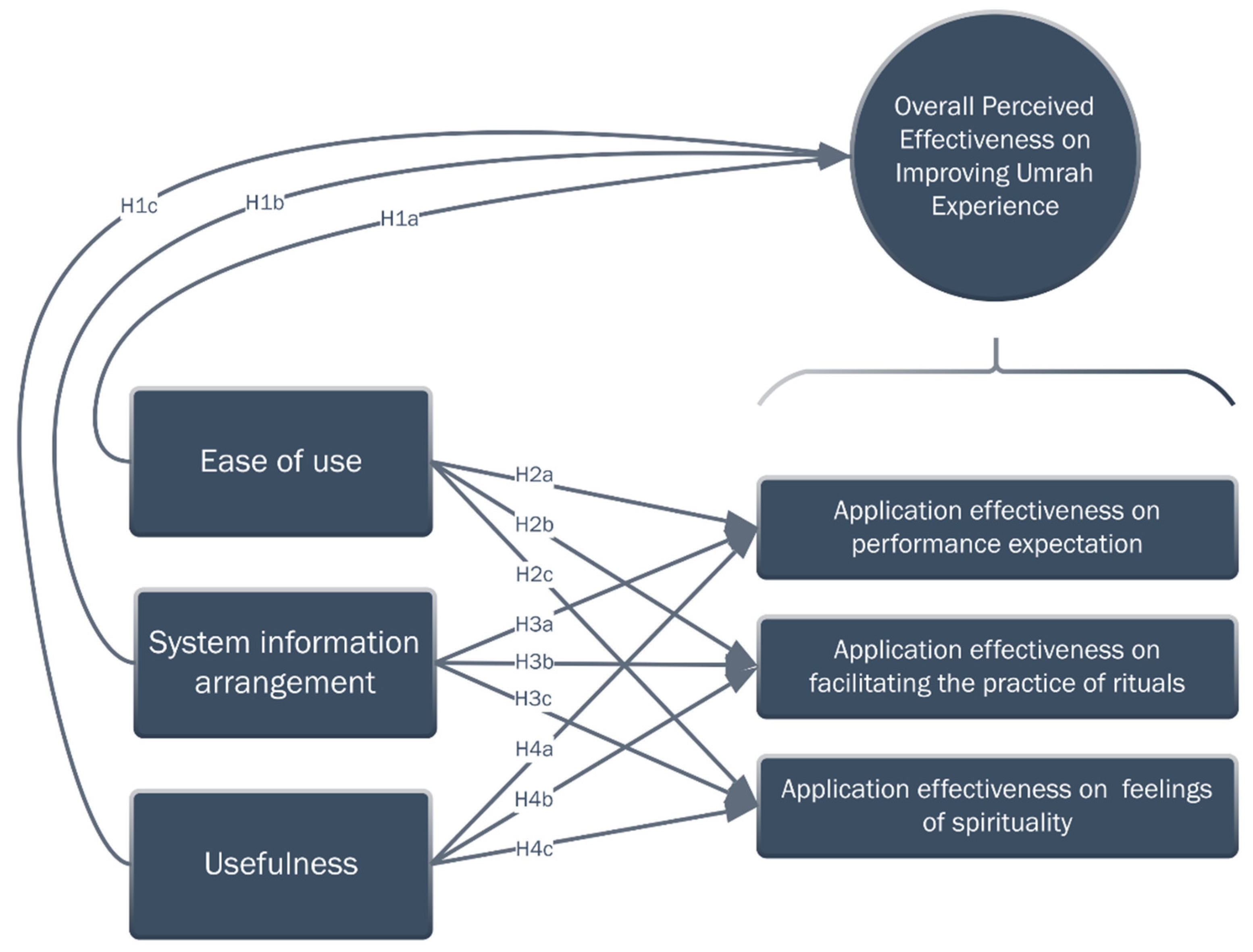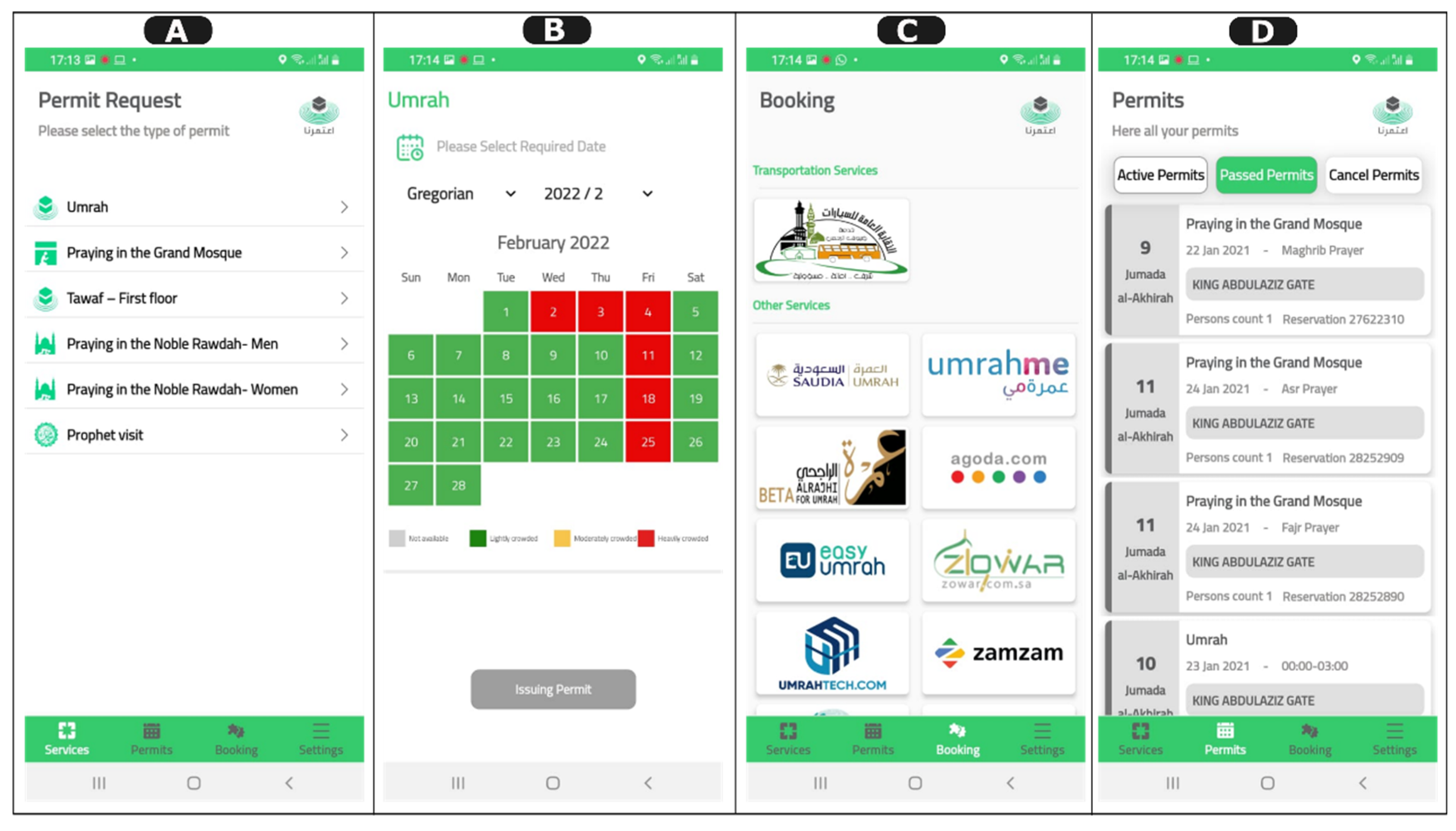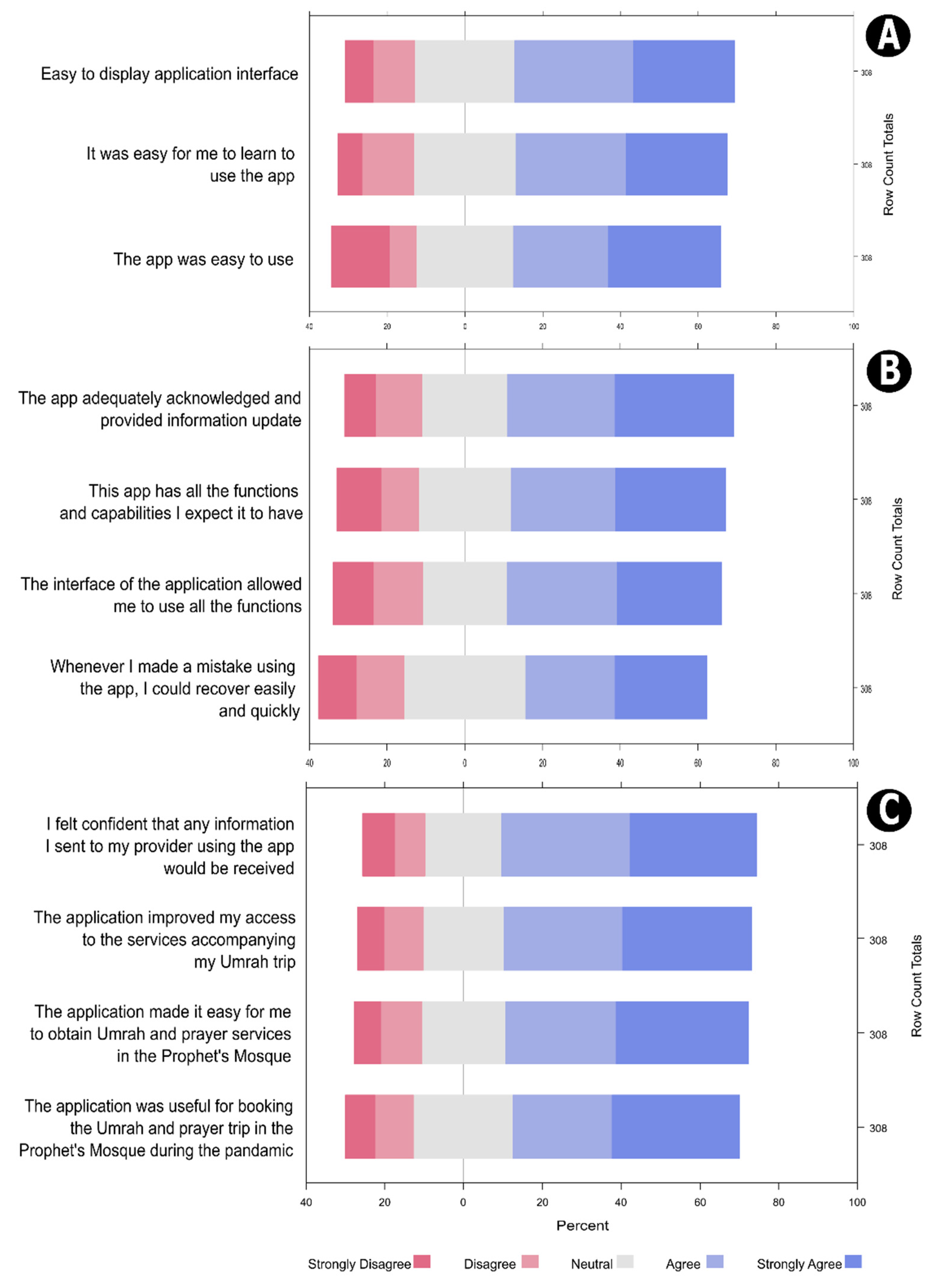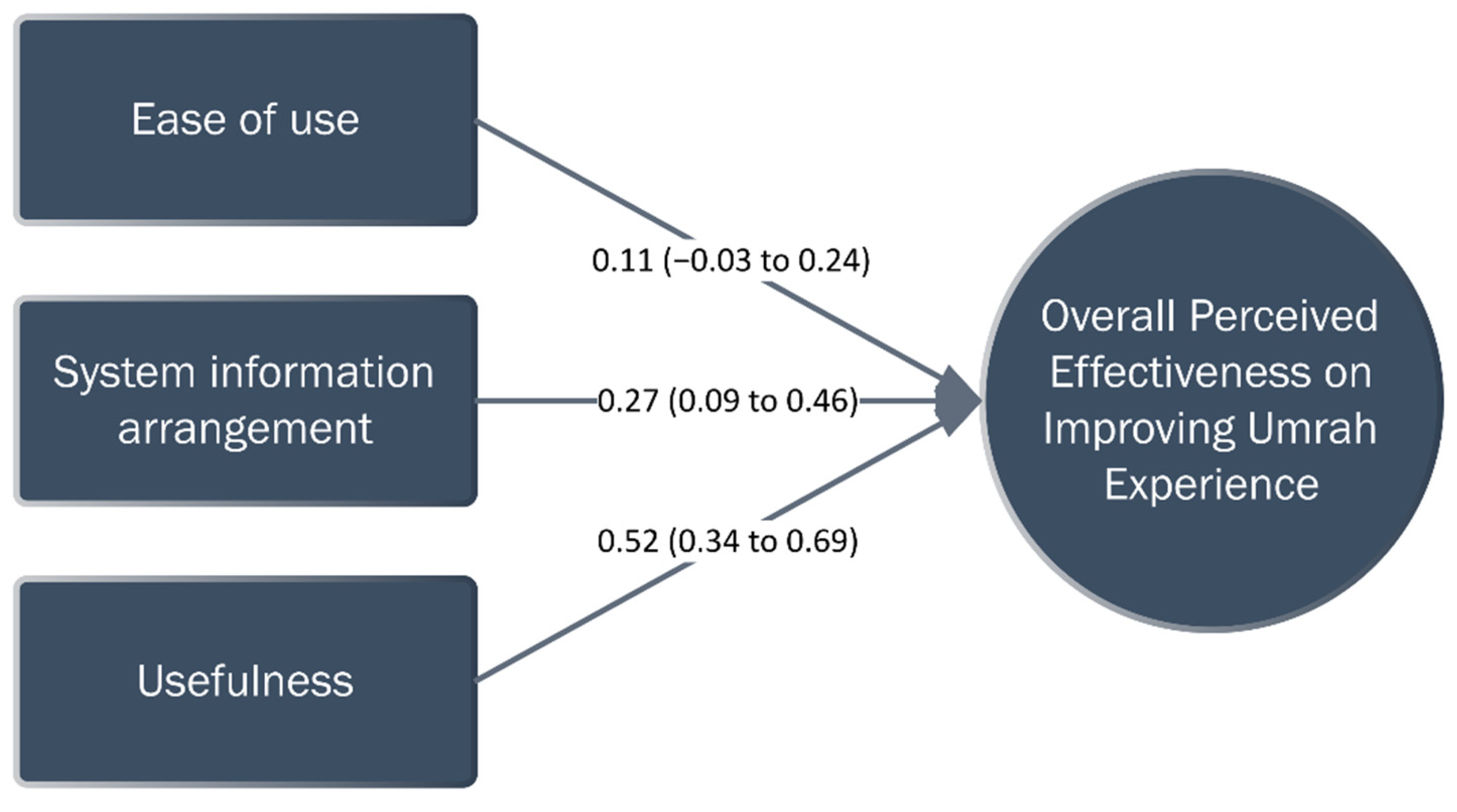The Impact of Eatmarna Application Usability on Improving Performance Expectancy, Facilitating the Practice of Rituals and Improving Spirituality Feelings during Umrah Amid the COVID-19 Outbreak
Abstract
:1. Introduction
2. Literature Review
2.1. Impacts of COVID-19 on Tourism Industry
2.2. Role of ICT during COVID-19 Crisis
2.3. The Effectiveness of ICT in Tourism during COVID-19 Crises
2.4. Managing Religious Tourism in the Light of COVID-19
3. Research Methods
3.1. Sample and Procedures
3.2. Eatmarna App
3.3. Measures
3.4. Statistical Analysis
4. Results
4.1. Demographic Characteristics of the Participants
4.2. Confirmatory Factor Analysis
4.3. Analysis of Participants’ Responses to Eatmarna Application Usability
4.4. Results of the Hypothesized Main Path
4.5. The Effects of Eatmarna Application Usability on Different Domains of Effectiveness in Improving Umrah Experience
5. Discussion
6. Strengths and Limitations of the Study and Opportunities for Further Research
7. Conclusions and Implications
Author Contributions
Funding
Institutional Review Board Statement
Informed Consent Statement
Data Availability Statement
Acknowledgments
Conflicts of Interest
References
- Almuhrzi, Hamed Mohammed, and Abdulaziz Mohammed Alsawafi. 2017. Muslim perspectives on spiritual and religious travel beyond Hajj: Toward understanding motivations for Umrah travel in Oman. Tourism Management Perspectives 24: 235–42. [Google Scholar] [CrossRef]
- Ayorekire, Jim, Bruce Micheal Byaruhanga, Francis Mugizi, and Joseph Obua. 2020. Opportunities and challenges of religious tourism development in Uganda: Policy, planning and institutional perspectives. The International Journal of Religious Tourism and Pilgrimage 8: 144–58. [Google Scholar]
- Bollen, Kenneth A. 1989. Structural Equations with Latent Variables. Hoboken: John Wiley & Sons, vol. 210. [Google Scholar]
- Campbell, Scott W., and Nojin Kwak. 2011. Mobile Communication and Civil Society: Linking Patterns and Places of Use to Engagement with Others in Public. Human Communication Research 37: 207–22. [Google Scholar] [CrossRef] [Green Version]
- Campbell, Heidi A., Brian Altenhofen, Wendi Bellar, and Kyong James Cho. 2014. There’sa religious app for that! A framework for studying religious mobile applications. Mobile Media & Communication 2: 154–72. [Google Scholar]
- De Ascaniis, Silvia, and Lorenzo Cantoni. 2016. Information and communication technologies in religious tourism and pilgrimage. International Journal of Religious Tourism and Pilgrimage 4: 3. [Google Scholar]
- Fornell, Claes, and David F. Larcker. 1981. Evaluating structural equation models with unobservable variables and measurement error. Journal of Marketing Research 18: 39–50. [Google Scholar] [CrossRef]
- Gössling, Stefan. 2020. Technology, ICT and tourism: From big data to the big picture. Journal of Sustainable Tourism 29: 849–58. [Google Scholar] [CrossRef]
- Gretzel, Ulrike, Matthias Fuchs, Rodolfo Baggio, Wolfram Hoepken, Rob Law, Julia Neidhardt, Juho Pesonen, Markus Zanker, and Zheng Xiang. 2020. e-Tourism beyond COVID-19: A call for transformative research. Information Technology & Tourism 22: 187–203. [Google Scholar] [CrossRef]
- Hannam, Kevin, Gareth Butler, and Cody Morris Paris. 2014. Developments and key issues in tourism mobilities. Annals of Tourism Research 44: 171–85. [Google Scholar] [CrossRef]
- Haryanto, Tri. 2020. Editorial: COVID-19 pandemic and international tourism demand. Journal of Developing Economies 5: 1. [Google Scholar] [CrossRef]
- Husain, Akbar. 2020. Coronavirus Pandemic: Effects, Prevention and Management. Delhi: The Readers Paradise. [Google Scholar]
- iso.org. 2018. Ergonomics of Human-System Interaction—Part 11: Usability: Definitions and Concepts. Available online: https://www.iso.org/obp/ui/#iso:std:iso:9241:-11:ed-2:v1:en (accessed on 21 January 2022).
- Kampel, Kim. 2020. COVID-19 and Tourism: Charting a Sustainable, Resilient Recovery for Small States. Available online: https://thecommonwealth.org/sites/default/files/inline/THT%20163%20FINAL.pdf (accessed on 15 December 2021).
- Kim, Jewoo, Choong-Ki Lee, and James W. Mjelde. 2016. Impact of economic policy on international tourism demand: The case of Abenomics. Current Issues in Tourism 21: 1912–29. [Google Scholar] [CrossRef]
- Kumar, Santus, and Shohel Md Nafi. 2020. Impact of COVID-19 pandemic on tourism: Recovery proposal for future tourism. GeoJournal of Tourism and Geosites 33: 1486–92. [Google Scholar]
- Kumudumali, S. Thakshila. 2020. Impact of COVID-19 on Tourism Industry: A Review. Available online: https://mpra.ub.uni-muenchen.de/102834/ (accessed on 15 December 2021).
- Lau, Arthur. 2020. New technologies used in COVID-19 for business survival: Insights from the Hotel Sector in China. Information Technology & Tourism 22: 497–504. [Google Scholar] [CrossRef]
- Mohandes, M. 2011. Pilgrim tracking and identification using the mobile phone. Paper presented at the 2011 IEEE 15th International Symposium on Consumer Electronics (ISCE), Singapore, June 14–17; pp. 196–99. [Google Scholar]
- Mróz, Franciszek. 2021. The Impact of COVID-19 on Pilgrimages and Religious Tourism in Europe During the First Six Months of the Pandemic. Journal of Religion and Health 60: 625–45. [Google Scholar] [CrossRef]
- Narbona, Juan, and Daniel Arasa. 2016. The role and usage of apps and instant messaging in religious mass events. International Journal of Religious Tourism and Pilgrimage 4: 29–42. [Google Scholar]
- Neidhardt, Julia, and Hannes Werthner. 2018. IT and tourism: Still a hot topic, but do not forget IT. Information Technology & Tourism 20: 1–7. [Google Scholar] [CrossRef] [Green Version]
- Overdijkink, Sanne B., Adeline V. Velu, Ageeth N. Rosman, Monique D. M. Van Beukering, Marjolein Kok, and Regine P. M. Steegers-Theunissen. 2018. The usability and effectiveness of mobile health technology–based lifestyle and medical intervention apps supporting health care during pregnancy: Systematic review. JMIR mHealth and uHealth 6: e8834. [Google Scholar] [CrossRef] [Green Version]
- Pavlović, Danijel S. 2020. COVID-19 and social distancing implications for religious activities and travel: The case of the Serbian Orthodox Church. International Journal of Religious Tourism and Pilgrimage 8: 112–20. [Google Scholar]
- Raj, Razaq, and Dino Bozonelos. 2020. COVID-19 pandemic: Risks facing Hajj and Umrah. International Journal of Religious Tourism and Pilgrimage 8: 93–103. [Google Scholar]
- Singh, Pranav Kumar, Sukumar Nandi, Kayhan Zrar Ghafoor, Uttam Ghosh, and Danda B. Rawat. 2021. Preventing COVID-19 Spread Using Information and Communication Technology. IEEE Consumer Electronics Magazine 10: 18–27. [Google Scholar] [CrossRef]
- Siyal, Abdul Waheed, Chen Hongzhuan, and Chen Gang. 2021. From Consumer Satisfaction to Recommendation of Mobile App–Based Services: An Overview of Mobile Taxi Booking Apps. SAGE Open 11: 21582440211004179. [Google Scholar] [CrossRef]
- statista.com. 2019. Annual Number of Hajj Pilgrims to Saudi Arabia from 1999 to 2019. Available online: https://www.statista.com/statistics/617636/saudi-arabia-domestic-hajj-pilgrims (accessed on 15 December 2021).
- Sulkowski, Lukasz, and Grzegorz Ignatowski. 2020. Impact of COVID-19 pandemic on organization of religious behaviour in different Christian denominations in Poland. Religions 11: 254. [Google Scholar] [CrossRef]
- Sultana, Sharmin, Tasnim Islam, and Mainul Islam. 2020. Impact of COVID-19 Pandemic on Top Tourist Destinations in the World. Journal of Tourism, Hospitality and Sports 50: 41–50. [Google Scholar] [CrossRef]
- Uğur, Naciye Güliz, and Adem Akbıyık. 2020. Impacts of COVID-19 on global tourism industry: A cross-regional comparison. Tourism Management Perspectives 36: 100744. [Google Scholar] [CrossRef]
- UN Habitat. 2020. Digital Technologies and the COVID-19 Pandemic, Briefing & Learning Note, Live Learning Experience: Beyond the Immediate Response to the Outbreak of COVID-19. Available online: https://www.uclg.org/sites/default/files/eng_briefing_technology_final_x.pdf (accessed on 15 December 2021).
- UNWTO. 2014. First UNWTO International Congress on Tourism & Pilgrimages Explores the Link Between Tourism and Spiritual Routes. Available online: https://www.unwto.org/archive/europe/press-release/2014-09-16/first-unwto-international-congress-tourism-and-pilgrimages-explores-link-be (accessed on 19 December 2021).
- UNWTO. 2020. UNWTO World Tourism Barometer (English Version). Available online: https://www.e-unwto.org/loi/wtobarometereng (accessed on 15 December 2021).
- Wagner, Rachel. 2013. You are what you install: Religious authenticity and identity in mobile apps. Digital Religion, 199–206. [Google Scholar]
- Werthner, Hannes, Aurkene Alzua-Sorzabal, Lorenzo Cantoni, Astrid Dickinger, Ulrike Gretzel, Dietmar Jannach, Julia Neidhardt, Birgit Pröll, Francesco Ricci, Miriam Scaglione, and et al. 2015. Future research issues in IT and tourism. Information Technology & Tourism 15: 1–15. [Google Scholar] [CrossRef]
- World Health Organization. 2021. Advice for the Public: Coronavirus Disease (COVID-19). Available online: https://www.who.int/emergencies/diseases/novel-coronavirus-2019/advice-for-public (accessed on 17 December 2021).
- Xiang, Zheng, Matthias Fuchs, Ulrike Gretzel, and Wolfram Höpken. 2019. Handbook of e-Tourism. Berlin and Heidelberg: Springer. [Google Scholar]
- Yasin, Raheel, Junaimah Jauhar, Noor Fareen Abdul Rahim, Sarah Namoco, and Mohammad Saleh Enaizan Bataineh. 2020. COVID-19 and Religious Tourism: An overview of impacts and implications. International Journal of Religious Tourism and Pilgrimage 8: 155–62. [Google Scholar]
- Zaman, Akib, Muhammad Nazrul Islam, Tarannum Zaki, and Mohammad Sajjad Hossain. 2020. ICT intervention in the containment of the pandemic spread of COVID-19: An exploratory study. arXiv arXiv:2004.09888. [Google Scholar]
- Zamani-Farahani, Hamira, and Riyad Eid. 2016. Muslim world: A study of tourism & pilgrimage among OIC Member States. Tourism Management Perspectives 19: 144–49. [Google Scholar] [CrossRef]
- Zhou, Leming, Jie Bao, I. Made Agus Setiawan, Andi Saptono, and Bambang Parmanto. 2019. The mHealth APP usability questionnaire (MAUQ): Development and validation study. JMIR mHealth and uHealth 7: e11500. [Google Scholar] [CrossRef]




| Parameter | Category | Frequency | Percentage |
|---|---|---|---|
| Age | 18–30 | 253 | 82.1 |
| 31–50 | 45 | 14.6 | |
| 51–65 | 10 | 3.2 | |
| Gender | Male | 69 | 22.4 |
| Female | 239 | 77.6 | |
| Education | No degree | 7 | 2.3 |
| Bachelor’s degree | 228 | 74.0 | |
| Master’s degree | 50 | 16.2 | |
| Doctoral degree | 22 | 7.1 | |
| Employment | Student | 3 | 1.0 |
| Education sector | 166 | 53.9 | |
| Academic sector | 31 | 10.1 | |
| Commercial sector | 24 | 7.8 | |
| Health sector | 14 | 4.5 | |
| Security sector | 13 | 4.2 | |
| Other | 51 | 16.6 | |
| Income (SAR) | <1000 | 73 | 23.7 |
| 1000–5000 | 82 | 26.6 | |
| 5000–10,000 | 105 | 34.1 | |
| 10,000–50,000 | 43 | 14.0 |
| Constructs and Factors | SFL | AVE | CR | Cα |
|---|---|---|---|---|
| Ease of use | 0.75 | 0.90 | 0.91 | |
| The app was easy to use | 0.97 | |||
| It was easy for me to learn to use the app | 0.93 | |||
| Easy to display application interface | 0.66 | |||
| System information arrangement | 0.70 | 0.90 | 0.90 | |
| Whenever I made a mistake using the app, I could recover easily and quickly | 0.92 | |||
| The app adequately acknowledged and provided information update | 0.78 | |||
| The interface of the application allowed me to use all the functions (such as services for booking accommodation, ticketing, transportation, obtaining permits and viewing information) that the application provides | 0.83 | |||
| This app has all the functions and capabilities I expect it to have | 0.82 | |||
| Usefulness | 0.73 | 0.91 | 0.91 | |
| The application was useful for booking the Umrah and prayer trip in the Prophet’s Mosque during covid 19 pandemic | 0.85 | |||
| The application improved my access to the services accompanying my Umrah trip during covid pandemic | 0.86 | |||
| The application made it easy for me to obtain Umrah and prayer services in the Prophet’s Mosque | 0.94 | |||
| I felt confident that any information I sent to my provider using the app would be received | 0.75 | |||
| Umrah experience | 0.75 | 0.90 | 0.90 | |
| The application is effective in helping pilgrims in the availability of a lot of services such as accommodation airlines reservation and Zamzam water | 0.90 | |||
| The application is effective in helping pilgrims in simplifying the rituals of the tawaf and the say | 0.90 | |||
| The application is effective in helping pilgrims in improving the feelings | 0.80 |
| Variables | 1 | 2 | 3 | 4 |
|---|---|---|---|---|
| 1. Ease of use | 1 | |||
| 2. System information arrangement | 0.71 ** | 1 | ||
| 3. Usefulness | 0.71 ** | 0.74 ** | 1 | |
| 4. Umrah experience | 0.64 ** | 0.70 ** | 0.74 ** | 1 |
| AVE | 0.75 | 0.70 | 0.73 | 0.75 |
| Square root of AVE | 0.86 | 0.84 | 0.85 | 0.87 |
| Mean | 3.52 | 3.50 | 3.71 | 3.66 |
| SD | 1.15 | 1.12 | 1.08 | 1.11 |
| Predictor | β (95% CI) | t-Value | p | Result |
|---|---|---|---|---|
| Dependent Variable: Performance expectancy; Model: F(8,293) = 39.33, R2 = 0.518, Adjusted R2 = 0.505 | ||||
| Ease-of-use | 0.12 (−0.01 to 0.26) | 1.77 | 0.079 | Not supported |
| System information arrangement | 0.31 (0.16 to 0.46) | 4.15 | <0.0001 | Supported |
| Usefulness | 0.46 (0.31 to 0.61) | 5.97 | <0.0001 | Supported |
| Dependent Variable: Facilitating the practice of rituals; Model: F(8,293) = 41.14, R2 = 0.529, Adjusted R2 = 0.517 | ||||
| Ease-of-use | 0.19 (0.06 to 0.31) | 2.94 | 0.004 | Supported |
| System information arrangement | 0.20 (0.06 to 0.34) | 2.90 | 0.004 | Supported |
| Usefulness | 0.44 (0.30 to 0.58) | 6.22 | <0.0001 | Supported |
| Dependent Variable: Feelings of spirituality; Model: F(8,293) = 39.67, R2 = 0.520, Adjusted R2 = 0.507 | ||||
| Ease-of-use | 0.09 (−0.04 to 0.21) | 1.30 | 0.196 | Not supported |
| System information arrangement | 0.35 (0.21 to 0.49) | 4.85 | <0.0001 | Supported |
| Usefulness | 0.42 (0.27 to 0.56) | 5.67 | <0.0001 | Supported |
Publisher’s Note: MDPI stays neutral with regard to jurisdictional claims in published maps and institutional affiliations. |
© 2022 by the authors. Licensee MDPI, Basel, Switzerland. This article is an open access article distributed under the terms and conditions of the Creative Commons Attribution (CC BY) license (https://creativecommons.org/licenses/by/4.0/).
Share and Cite
Hassan, T.H.; Salem, A.E.; Refaat, S.A. The Impact of Eatmarna Application Usability on Improving Performance Expectancy, Facilitating the Practice of Rituals and Improving Spirituality Feelings during Umrah Amid the COVID-19 Outbreak. Religions 2022, 13, 268. https://doi.org/10.3390/rel13030268
Hassan TH, Salem AE, Refaat SA. The Impact of Eatmarna Application Usability on Improving Performance Expectancy, Facilitating the Practice of Rituals and Improving Spirituality Feelings during Umrah Amid the COVID-19 Outbreak. Religions. 2022; 13(3):268. https://doi.org/10.3390/rel13030268
Chicago/Turabian StyleHassan, Thowayeb H., Amany E. Salem, and Sameh A. Refaat. 2022. "The Impact of Eatmarna Application Usability on Improving Performance Expectancy, Facilitating the Practice of Rituals and Improving Spirituality Feelings during Umrah Amid the COVID-19 Outbreak" Religions 13, no. 3: 268. https://doi.org/10.3390/rel13030268
APA StyleHassan, T. H., Salem, A. E., & Refaat, S. A. (2022). The Impact of Eatmarna Application Usability on Improving Performance Expectancy, Facilitating the Practice of Rituals and Improving Spirituality Feelings during Umrah Amid the COVID-19 Outbreak. Religions, 13(3), 268. https://doi.org/10.3390/rel13030268







